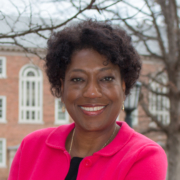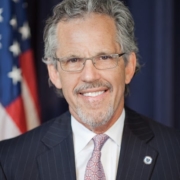Justin Driver
Constitutional Law and Public Schools, Part 1
Do constitutional rights stop at the schoolhouse gate? Are American students, in other words, granted the freedom and protections outlined in the US constitution?
 This question doesn’t have an easy answer.
This question doesn’t have an easy answer.
My guest for the next two episodes is Justin Driver. In his new book, The Schoolhouse Gate: Public Education, the Supreme Court, and the Battle for the American Mind, Justin explores most if not all Supreme Court rulings on students in public education.
In the first part of my conversation with Justin, we explore the constitutional significance of school rulings and focus much of our attention on the issue of race.
Justin Driver is the Harry N. Wyatt Professor of Law at the University of Chicago Law School. His first book,The Schoolhouse Gate(2018 Pantheon), is receiving rave reviews. The New York Times called it “indispensable” while the Washington Post called it “masterful.”
Citation: Driver, Justin, interview with Will Brehm, FreshEd, 134, podcast audio, November 12, 2018. https://www.freshedpodcast.com/driver-p1/
Will Brehm 2:15
Justin Driver, welcome to FreshEd.
Justin Driver 2:18
Glad to be with you, Will. Thanks.
Will Brehm 2:19
So, I want to just jump right into this and ask why is public school a significant location to even study constitutional issues?
Justin Driver 2:28
Yeah, we don’t often think about public schools as legal entities, but they are, in fact, animated by Supreme Court decisions affecting constitutional law. It’s also true that the public school is the first place that most people encounter the government for sustained periods in their time. There are more than 50 million public school students in the country and it takes several million of adults to run schools and that means that about one sixth of the American population is in public school on school days. It’s also true that I am particularly drawn to examining constitutional law and the public schools because the disputes that enter the school often are reflective of larger cultural anxieties that exist throughout the nation. And so, one of the arguments that I make in the book is that by tracing these particular conflicts, one can understand the last 100 years of American history. So those are a couple of reasons why I think this is a particularly important area to study.
Will Brehm 3:43
And so, for much of the history of the Supreme Court though, the justices rarely ruled on education, on school. So, what was the general logic historically that the court took when it came to schools and the Constitution?
Justin Driver 4:00
Yeah, the first case that I write about in much depth chronologically, is a case called Cumming v. Richmond, where a community in Georgia closed its high school for black students but kept its high school for white students open. And the Supreme Court of the United States refused to find that was a violation of the equal protection clause. Even though you might regard these schools as some people have said as separate and unequal, right. There’s no high school for black students. Nevertheless, the Supreme Court said, in effect, that these are local matters that the Constitution of the United States says nothing about one way or another. We’re not going to get involved in this quintessentially local arena. And that rationale was representative of the overall approach for many years.
Will Brehm 4:59
And another case that I often think about is Plessy v. Ferguson, but I always associated it with schools, but in fact, it was about train cars. Could you just explain the logic of that case and how it fit into this sort of historical narrative of education being seen as a local issue?
Justin Driver 5:18
Sure. So, Plessy v. Ferguson is a case that’s decided in 1896. Louisiana has a racially separate rail system. The language that many people identify with Plessy v. Ferguson is “separate but equal”. That language comes, not from the Supreme Court opinion, but it actually comes from the Louisiana statute in question. And the Supreme Court decision written by Justice Brown, says that if racial classifications are reasonable then they pass constitutional muster. Justice Harlan, of course, wrote a famous dissenting opinion where he says that our Constitution is colorblind. Interestingly, for our purposes, Justice Harlan wrote the majority opinion in Cumming v. Richmond, which we spoke about a moment ago, upholding the closing of the black school. And this suggests that Justice Harlan is not quite the avatar of modern racial enlightenment that some Supreme Court Justices hold him out to be.
Will Brehm 6:33
And looking at these two cases, Plessy v. Ferguson and Cumming v. Richmond, you say that African Americans at the time, in the 19th century, the court basically provided civil equality but denied African Americans’ social equality. Can you explain what the difference was at that time?
Justin Driver 6:55
Yeah, so this is an unusual thing to our modern ears. We think of equality as being a largely undifferentiated concept. But in the 19th century it was divided into a few different categories including, as you suggest, civil equality on the one hand, and social equality on the other. Civil equality would have meant the ability to enter into contracts and things of that nature whereas social equality would have meant the sort of things that lead to interracial intimacy, including interracial marriage, but also importantly, for purposes, integrated schooling would have been regarded as socially equality. And so, Justice Harlan dissented in the Plessy v. Ferguson decision because he viewed rail cars as involving civil equality. Evidently because people were buying tickets for rail cars, he viewed that as being civil equality, whereas the Justices in the majority in Plessy v. Ferguson would have regarded the rail car separation as a form of social equality. And so, Justice Harlan is able to write the Cumming v. Richmond opinion because he viewed integrated schooling also. And he would have regarded that with schooling matters as involving social equality, and therefore, the Equal Protection Clause would have said nothing about that whatsoever.
Will Brehm 8:27
So, it seems like a lot of the sort of beginning cases of the Supreme Court in education or in public schooling in particular, were really about saying, schooling is this local issue, and we’re not going to get involved too much. Separate but equal is okay. So, when did the Supreme Court actually take more of a stance that said, okay, the state is actually infringing on civil liberties of students or of individuals when it came to schools? When did that actually happened?
Justin Driver 9:01
Yeah, beginning in the 1920s, the Supreme Court begins its involvement with education. It’s important to say that the major cases from the 1920s did not involve public schools but were instead thinking about constitutional infringements by the state with respect to private schools. One case from the 1920s is a case called Pierce v. Society of Sisters. There, Oregon passed a measure that required all students to attend public schools. In other words, it sought to outlaw private schools and in particular, parochial schools. The measure was backed by the Ku Klux Klan and their fear was that Catholic schools prevented Catholics from being what they would have referred to as “Americanized”. The Supreme Court of the United States invalidated that measure and said in resident language, the child is not the mere creature of the state. And so, Pierce v. Society of Sisters along with another pair of decisions, that was an important intervention and step on the path toward finding that public school students also had constitutional rights within the public school.
Will Brehm 10:31
I find that pretty amazing that it took so long to recognize that students, American students, had constitutional rights like American adults. I guess that’s the separation here.
Justin Driver 10:47
Yeah, that’s right. It is a striking phenomenon. One of the things that jumped out at me as I was working on this book was the incredibly contingent nature of constitutional decision making. And we sometimes think that constitutional law is sort of foreordained and this was anything but, in the sense, that the development in this area was hardly something that would have been foreseen at the beginning. And so, it was very much unfolded in fits and starts and quiet plausibly, many of the most important decisions could have been decided the other way. So, what jumps out at you is also something that’s striking to me.
Will Brehm 11:32
And one of the most important decisions that I think you highlight in your book is Tinker v. the Des Moines Independent Community School District. Could you explain what that case was and how that’s relevant to seeing students as having constitutional rights?
Justin Driver 11:49
Yes. So, Tinker is a case out of Des Moines, Iowa, where in the 1960s students want to wear black armbands in protest of the Vietnam War. This is in December 1965, long before there’s any mass mobilization against the Vietnam War. When the Des Moines school officials got wind of this plan, they said, “Oh, no, this is too hot of a topic. We have a graduate of the Des Moines schools who died over in Vietnam. And he still has buddies here. And if you all wear black armbands, his friends are going to regard you as dishonoring his legacy” and so they said, “You can’t wear the armband and said that you are unwelcome to attend school as long as you wear the armbands”. And at the time it’s a really open question as to whether students have first amendment rights. Justice Fortas writes a magnificent opinion and it gives me the title for my book, he says, “It can hardly be argued that students shed their constitutional rights at the schoolhouse gate”. Justice Black wrote a vehement dissenting opinion, where he says, students are there to be seen and not heard. Our society is too permissive. And, in effect, the youth culture is spiraling out of control. Justice Black gave his descent from the bench and he spoke for more than 20 minutes. That’s a signal of unusual, deep displeasure with the majority’s opinion. It’s not merely that the majority was wrong for Justice Black, it’s that they were dead wrong. So, he spoke for a really long time, he was fairly frothing at the mouth and Chief Justice Warren is reported to have said, “Old Hugo really got caught up in his jockstrap on that one”. And so, it’s a really remarkable opinion. But, you know, the opinion by Justice Fortas, it was significant because it reconceptualized the role of students in American society. Fortas, the real sort of innovation here is that, he says that, “Students are not merely receptacles that teachers fill with information. Instead, students talking to each other about the issue of the day is not some sort of distraction but instead a vital part of the educational process itself”. So, I think of Tinker as a really important breakthrough. Unfortunately, in my view, the court has failed to build on Tinker in the way that it should have.
Will Brehm 14:41
So, what happened since then? I mean, it seems like giving agency to students in the educational process -by giving them constitutional rights, the ability to have free speech, advanced ideas in their own way, challenge ideas that are seen as normative -that seems like, in my mind, a good thing. I mean, you’re saying that that has actually sort of shifted to the other direction, towards Justice Black’s dissent?
Justin Driver 15:09
Justice Black’s dissent continues to be embraced by Justice Thomas. He wrote an opinion in a case called Morse v. Frederick from 2007 that Justice Black was exactly right, and that Tinker was wrongly decided, students should have no first amendment rights whatsoever. Justice Thomas, of course, is an originalist and he said that, you know, in the original understanding, teachers commanded, and students obeyed and so it was quite striking that he waxes nostalgic. Justice Thomas’ views are not representative of the current court but in recent years -in recent decades- the court has carved out a number of exceptions to the foundational rule of Tinker including in the Morse vs. Frederick case itself. I should say I’m calling it Morse v. Frederick but just about nobody calls it Morse v. Frederick. Instead, it’s routinely referred to by lawyers as “the Bong Hits 4 Jesus case”. That message was on a 14-foot-long banner that a high school senior in Juneau, Alaska unfurled from across the school as the Olympic torch made its way down glacier Avenue in Juneau, Alaska. The principal sees Joseph Frederick unfurl this banner, marches across the way, rips the sign out of his hand, and then suspends him from school. And the question is, does this violate his first amendment rights? The Supreme Court in a very odd opinion written by Chief Justice Roberts said that if the school believes that the speech is designed to promote illegal drug use, then it’s permissible to punish the student for that speech. And I say that’s unusual from a First Amendment perspective because it’s a hallmark of the freedom of speech that you’re supposed to be neutral with respect to viewpoint. You can’t silence pro-drug speech if anti-drug speech is permissible because the marketplace of idea, you should allow people to have their say. Justice Stevens wrote a really important dissenting opinion in this area. He was quite elderly at the time. And he said that he could remember prohibition, and that we should in effect view Joseph Frederick, as attempting to participate, however, inarticulately, in a growing debate about the legality of marijuana. And of course, he means by that, with respect to prohibition, that what is illegal today can become legal tomorrow. And of course, 11 years have passed since the “Bong hits 4 Jesus” decision and Justice Stevens’ dissent assumes only added significance and force.
Will Brehm 18:07
Do you think that the “Bong hits 4 Jesus” ruling would be overturned in this new era where marijuana is becoming increasingly legalized?
Justin Driver 18:16
It’s a good question. The court is typically reluctant to reverse itself and to overturn precedents. I do, however, hope that the Supreme Court will demonstrate renewed interest in vindicating students’ speech. The Roberts Court has a reputation as being a staunch defender of the freedom of expression. Indeed, some people think it’s rather too enamored of the freedom of speech and identifies infractions where they don’t properly belong. But one major area where it has failed to vindicate free speech rights is students’ speech. And so, I do hope that the court would be willing to revisit Morse v. Frederick and also build on Tinker. Let me give you an example. You know, the Tinker case, the rule that emerged from that was that if teachers have a reasonable forecast of a substantial disruption then it’s permissible to punish students for speech. But the problem with that rule is that it reads in what might be regarded as a “hecklers veto”. This is a term that first amendment mavens use to describe when particularly sensitive listeners can, if they object vociferously enough to the speech, decide to silence speech. And so, we see many of these cases where students grow upset and they can threaten their classmates and rather than talking to the folks that are threatening violence or unrest, instead, too often, in my view, school officials silence the speech. And so, I find that a distressing development and I do hope that the court will revisit this issue.
Will Brehm 20:15
Yeah, it’s so fascinating that even today, it seems like constitutional rights literally stop at the schoolhouse gate. That children, that young adults, are viewed fundamentally different as citizens, right? They don’t have the same necessarily constitutional rights as adults, for instance. And I guess, for me, what’s so interesting is that the issue of race in your book sort of cuts across all of the different cases that you profile, that you go through in such great depth. And, in a sense, this idea of separate but equal from Plessy v. Ferguson and the idea that you don’t want this interracial mixing going on because maybe children are seen as innocent and, you know, corruptible and mixing races is going to have some sort of negative outcome. That seems to be a recurrent theme over many different cases. And of course, the big case that people probably always associate with education is Brown v. the Board of Education. So, can you talk a little bit about what did Brown v. Board of Education actually do? And maybe more importantly, what didn’t it do?
Justin Driver 21:29
Yeah, it’s a great question. Brown v. Board of Education is the most widely celebrated opinion. Today, Judge Kavanaugh, during his confirmation hearings said that he thought that Brown v. Board of Education was the most important decision in the Supreme Court’s history. More important than Marbury v. Madison in an important early case dealing with judicial review. But even though everybody sort of knows Brown, people have widely different views about what the opinion actually held. So, this is a case from 1954 dealing with racial segregation by law in the nation’s public schools. There are 17 different states that require Jim Crow and another four states that permitted Jim Crow, including Topeka, Kansas. And so Chief Justice Warren writes a unanimous opinion, saying that in the realm of education separate is inherently unequal. But the question becomes exactly as you suggested, Will. What does Brown mean? Does Brown nearly forbid segregation? Or does Brown require integration? And so, the decision itself set off a fierce debate to control the meaning of Brown and ultimately, it’s my argument that I advanced in the book that the erstwhile segregationist successfully claimed the mantle of Brown.
Will Brehm 23:09
How so?
Justin Driver 23:10
So, in 1956, Senator Sam Ervin of North Carolina helped to mastermind a document called the Southern Manifesto. Senator Ervin was a graduate of Harvard Law School and a former Justice on the North Carolina Supreme Court. He was quite legally sophisticated and also a staunch segregationist. And he said -right around the time of the Southern Manifesto, which was a document that said that Brown was wrongly decided- he made a public statement where he argues, “Brown is a deplorable decision and it’s also not as drastic as people think”, he says. And so, over time, he eased away from the first part of that construction, that it was deplorable, and said, it’s not as drastic as people think, meaning that he contended, Brown does not require integration. And indeed, over time beginning in the 1960s, he would say that Brown, properly understood, forbids the efforts of school districts to require integration. And that is an argument that ultimately carried the day in a case called Parents Involved in Community Schools from 2007 which was decided when I was a law clerk at the Supreme Court for justice Breyer.
Will Brehm 24:39
And what did that ruling state?
Justin Driver 24:41
So, in Parents Involved, the court considered plans out of Louisville, Kentucky, and Seattle, Washington. They wanted to have greater amounts of racial integration than would flow from assigning people simply to their neighborhood schools. They say we have racially diverse cities, but our schools are racially isolated. And so, in order to make sure that the schools are reflective of the greater racial diversity than we have in our cities, we’re going to take account of race in order to bring about racial integration. Chief Justice Roberts writes an opinion that effectively claims the mantle of Brown and says that it forbids these sorts of programs. He says that Brown invalidated regimes that told students where they could go to school based on the color of their skin. These programs in Louisville and Seattle tell students where they can go to school based on the color of their skin. It matters not one wit, for constitutional purposes, according to Chief Justice Roberts that the programs in the modern era were designed to bring people together and that in the Jim Crow era, they were designed to keep people apart, and indeed keep racial minorities subordinate.
Will Brehm 25:57
It reminds me of the book, ‘Through the Looking Glass’. It’s like everything is turned upside down. You know, like, how did we go from seeing Brown -as celebrating Brown to reintegrate schools, to get rid of segregation- to having, in 2007, a Supreme Court Justice, use Brown to argue, basically, segregated schools. As so many students today know -I mean, even myself. I went to school in the US and I’ve seen so many public schools that were either 99% minority students, or 99% white students, and it’s so obvious that schools are so segregated today in America.
Justin Driver 26:42
Yeah, it’s it was a very upsetting decision for me, when I was a law clerk to Justice Breyer and Justice Breyer wrote a very long and in my unbiased view, wholly, convincing, dissenting opinion, where he says that it is a cruel distortion of history to compare Topeka, Kansas of the 1950s to Louisville and Seattle of the modern era and he offered what we could think of as an integrationist conception of the reconstruction amendments. Unfortunately, though Justice Breyer’ opinion did not carry the day.
Will Brehm 27:19
Well, Justin Driver, thank you so much for joining FreshEd. It really was a pleasure of talking today.
Coming soon!
Coming soon!









